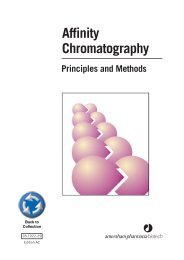Tabletop Rotors and Tubes
Tabletop Rotors and Tubes
Tabletop Rotors and Tubes
Create successful ePaper yourself
Turn your PDF publications into a flip-book with our unique Google optimized e-Paper software.
3<br />
Using <strong>Tubes</strong> <strong>and</strong> Accessories<br />
This section contains general instructions for filling <strong>and</strong> capping the<br />
labware used in Beckman Coulter preparative rotors, for selecting<br />
<strong>and</strong> using the appropriate accessories, <strong>and</strong> for recovering samples<br />
after a run. Individual rotor manuals provide specific instructions on<br />
tubes <strong>and</strong> accessories that can be used in a particular rotor. 1<br />
Rotor use instructions are in Section 4. A table of chemical resistances<br />
is in Appendix A of this manual. Reference information on<br />
some commonly used gradient materials is in Appendix C.<br />
GRADIENT PREPARATION<br />
Added<br />
First<br />
Added<br />
Last<br />
5%<br />
10%<br />
15%<br />
20%<br />
Many commercial gradient formers are available. These devices<br />
usually load a tube by allowing the gradient solutions to run down the<br />
side of the tube. The heaviest concentration is loaded first, followed<br />
by successively lighter concentrations. This method is acceptable for<br />
wettable tubes; however, loading a nonwettable tube (such as Ultra-<br />
Clear, polyallomer, 2 <strong>and</strong> polycarbonate) by allowing solutions to run<br />
down the side of the tube can cause mixing.<br />
Gradients in nonwettable tubes can be prepared using a gradient<br />
former by placing a long syringe needle or tubing to the tube bottom<br />
<strong>and</strong> reversing the gradient chambers. In that way the lightest gradient<br />
concentration is loaded first, underlayed by increasingly heavier<br />
concentrations.<br />
1 A complete list of tubes, bottles, <strong>and</strong> adapters is provided in the latest edition of the Beckman Coulter Ultracentrifuge <strong>Rotors</strong>, <strong>Tubes</strong><br />
& Accessories catalog (BR-8101), available at www.beckmancoulter.com.<br />
2 It has been reported, however, that polyallomer tubes have been made wettable by soaking them in a chromic acid bath for about 30 minutes (see<br />
Preparation of Polyallomer Centrifuge <strong>Tubes</strong> for Density Gradients, Anal. Biochem. 32:334-339. H. Wallace, 1969). Also, a method of making<br />
Ultra-Clear tubes wettable that has proven successful for some users is described at the end of this section.<br />
<strong>Tabletop</strong> Ultracentrifuge <strong>Rotors</strong> <strong>and</strong> <strong>Tubes</strong><br />
3-1

















